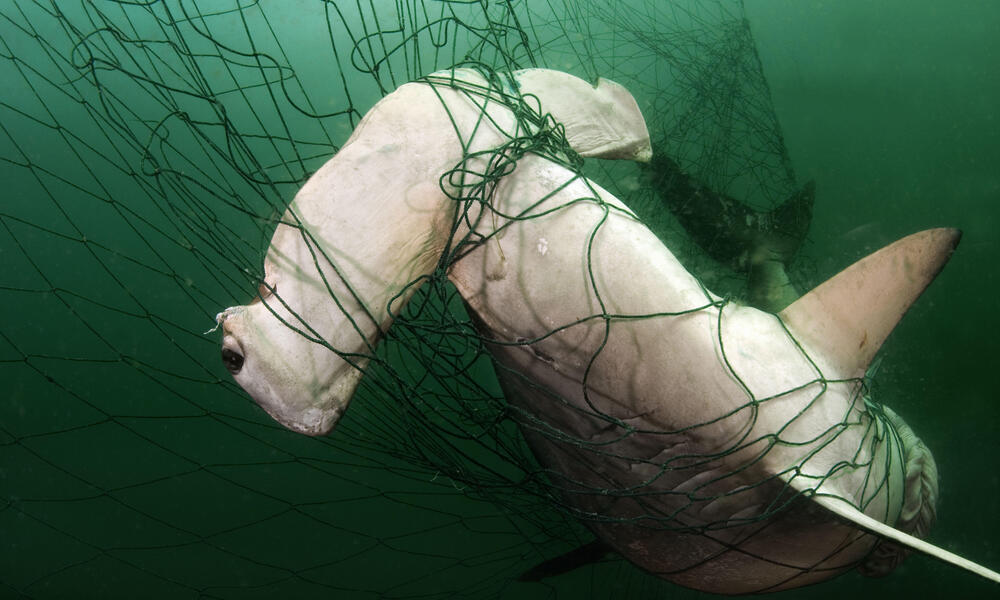The overfishing of sharks happens because of the huge demand—mainly for shark fins—and a lack of management to ensure shark fisheries are sustainable. Some species, such as spiny dogfish and porbeagle, are targeted primarily for their meat.
The oceanic whitetip, porbeagle and three hammerhead species are some of the shark species of concern for WWF, where the impact of trade is contributing to declines in populations. Millions of these sharks continue to be fished annually to supply the persistent demand for their fins and meat. Controls on fishing are woefully insufficient. As a result, the oceanic whitetip, porbeagle, and the smooth hammerhead are classified as vulnerable by the IUCN, while scalloped and great hammerhead sharks are classified as endangered.
Threats to pelagic sharks
Overfishing is the overwhelming threat, with open ocean longlines using hundreds if not thousands of hooks each catching the greatest volume of sharks globally. While these fisheries may be primarily targeting tuna and billfishes such as marlin, the sharks caught are an important source of income, particularly their fins. Tuna purse-seiners also catch sharks, although these have a better chance of being released alive, while gill nets are an ecological disaster, catching almost anything in their path, including whales, dolphins, turtles and sharks.
While the oceans are vast, there are few refuges from industrial fishing, and some pelagic species, such as the oceanic whitetip have suffered massive population losses due to their inability to reproduce more quickly. Seventeen out of the 39 pelagic shark species are threatened with extinction.
Threats to reef sharks
As with most shark species, overfishing is by far the biggest threat to most larger reef sharks, while damage to reef and other key habitats is also having an impact. The clearance of mangroves has a negative impact on species whose young use these as nursery grounds. The loss of living coral reefs due to sedimentation and fertilizer run-off from farmland, and climate change, will often reduce the amount of prey for sharks. Many kinds of food fishes that humans like to eat inhabit reefs, and so reefs are targeted by fishers, using types of fishing that also catch sharks.
Some 25% of all the 494 sharks and rays inhabiting coastal continental shelves, which includes all reef sharks, are threatened with extinction. There may be many more as the conservation status of 35% is not yet known.
Threats to rays
In the ray's marine realm, overfishing is the largest threat. Some of the most valuable fins in the shark fin trade are from shark-like rays, such as sawfishes and large guitarfishes, while the meat of many species of rays and skate are also eaten in coastal communities.
Five out of the seven families of elasmobranch most threatened with extinction are rays.

 Whale Shark
Whale Shark
 Great White Shark
Great White Shark





 Sea Turtle
Sea Turtle
 Vaquita
Vaquita
 Dugong
Dugong
 Humphead Wrasse
Humphead Wrasse
 Pacific Salmon
Pacific Salmon
 Dolphins and Porpoises
Dolphins and Porpoises
 Whale
Whale
 Seals
Seals
 Sea Lions
Sea Lions
 Marine Iguana
Marine Iguana
 Tuna
Tuna
 Bluefin Tuna
Bluefin Tuna
 Sei Whale
Sei Whale
 Yellowfin Tuna
Yellowfin Tuna
 Hawksbill Turtle
Hawksbill Turtle
 Skipjack Tuna
Skipjack Tuna
 Loggerhead Turtle
Loggerhead Turtle
 Leatherback Turtle
Leatherback Turtle
 Green Turtle
Green Turtle
 Olive Ridley Turtle
Olive Ridley Turtle
 Albacore Tuna
Albacore Tuna
 Bigeye Tuna
Bigeye Tuna
 North Atlantic Right Whale
North Atlantic Right Whale
 Blue Whale
Blue Whale
 Fin Whale
Fin Whale
 Bowhead Whale
Bowhead Whale
 Gray Whale
Gray Whale
 Hector's Dolphin
Hector's Dolphin
 Galápagos Penguin
Galápagos Penguin
 Polar Bear
Polar Bear
 Narwhal
Narwhal
 Beluga
Beluga
 Giant Tortoise
Giant Tortoise
 African Wild Dog
African Wild Dog
 African Elephant
African Elephant
 Black Rhino
Black Rhino
 White Rhino
White Rhino
 Rhino
Rhino